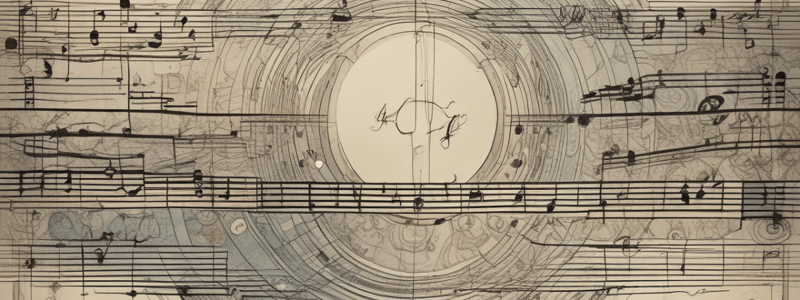Podcast
Questions and Answers
What is the characteristic of symmetrical scales?
What is the characteristic of symmetrical scales?
- They create a sense of resolution
- They are constructed using repeated intervals (correct)
- They are used only in classical music
- They are limited to five unique pitches
What is the formula for the whole-tone scale?
What is the formula for the whole-tone scale?
- W-H-W-H-W-H
- W-W-H-W-H-W
- H-W-H-W-H-W
- W-W-W-W-W-W (correct)
How many unique pitches per octave does the whole-tone scale have?
How many unique pitches per octave does the whole-tone scale have?
- 7
- 6 (correct)
- 5
- 8
What is the whole-tone scale commonly used for in music?
What is the whole-tone scale commonly used for in music?
What is the formula for the diminished scale?
What is the formula for the diminished scale?
How many unique pitches per octave does the diminished scale have?
How many unique pitches per octave does the diminished scale have?
What is the diminished scale commonly used for in music?
What is the diminished scale commonly used for in music?
What is another name for the diminished scale?
What is another name for the diminished scale?
What is the Lydian ♯2 mode derived from?
What is the Lydian ♯2 mode derived from?
What is the altered scale commonly used in?
What is the altered scale commonly used in?
What is the benefit of experimenting with exotic scales and modes in different musical contexts?
What is the benefit of experimenting with exotic scales and modes in different musical contexts?
What is the result of incorporating exotic scales and modes into your playing?
What is the result of incorporating exotic scales and modes into your playing?
What is the characteristic of the Lydian ♯2 mode?
What is the characteristic of the Lydian ♯2 mode?
What is the benefit of embracing the diversity and nuances of exotic scales and modes?
What is the benefit of embracing the diversity and nuances of exotic scales and modes?
What is the formula for the octatonic scale?
What is the formula for the octatonic scale?
What is the characteristic of the Phrygian dominant scale?
What is the characteristic of the Phrygian dominant scale?
What is the benefit of using symmetrical scales in composition?
What is the benefit of using symmetrical scales in composition?
What is the characteristic of the Hungarian minor scale?
What is the characteristic of the Hungarian minor scale?
What is the origin of the Hijaz scale?
What is the origin of the Hijaz scale?
What is the characteristic of the Indian Raga scales?
What is the characteristic of the Indian Raga scales?
What is the starting point for constructing an octatonic scale?
What is the starting point for constructing an octatonic scale?
What is the characteristic of the Locrian ♮6 mode?
What is the characteristic of the Locrian ♮6 mode?
What is the benefit of using exotic scales and modes in composition?
What is the benefit of using exotic scales and modes in composition?
What is the characteristic of the Japanese Hirajōshi scale?
What is the characteristic of the Japanese Hirajōshi scale?
Study Notes
Symmetrical Scales
- Symmetrical scales are constructed using repeated intervals, creating a sense of tension, ambiguity, and chromaticism.
- These scales are valuable tools for advanced applications in music theory and composition.
Whole-Tone Scale
- Consists entirely of whole steps, resulting in a dreamy and ethereal quality.
- Hexatonic scale, meaning it has six unique pitches per octave.
- Formula: W-W-W-W-W-W.
- Example: Starting on C, the whole-tone scale is C-D-E-F#-G#-A#.
- Commonly used in jazz and impressionist music to create a sense of suspension, ambiguity, and tonal ambiguity.
Diminished Scale
- Eight-note scale that alternates between whole steps and half steps.
- Often referred to as the octatonic scale due to its eight unique pitches per octave.
- Formula: W-H-W-H-W-H-W-H.
- Example: Starting on C, the diminished scale is C-D-D#-E#-F#-G-A-A#.
- Commonly used in various musical genres, from classical to jazz and beyond.
- Highly versatile and can be applied in melodic, harmonic, and improvisational contexts.
Octatonic Scale
- Eight-note scale that alternates between whole steps and half steps, just like the diminished scale.
- Starts with a whole step, followed by alternating half and whole steps until the scale is completed.
- Formula: W-H-W-H-W-H-W-H-W.
- Example: Starting on C, the octatonic scale is C-D-D#-F-F#-G#-A-B.
- Combines both the characteristics of the whole-tone scale and the diminished scale, creating a unique tonal palette.
- Often used in jazz, film music, and contemporary classical music to add color and tension to compositions.
Exotic Scales
- Exotic scales and modes add depth and an intriguing flavor to compositions.
- Incorporating these unique scales and modes into your playing can create a distinct sound and explore a world of musical possibilities.
Eastern Scales
- Derived from Eastern musical traditions, featuring intervals that are different from the familiar major and minor scales.
- Examples: Phrygian dominant scale (Spanish scale or flamenco scale), Hijaz scale, and Persian scale (Dorian b2 scale).
Other World Scales
- Derived from different parts of the world, offering unique qualities.
- Examples: Hungarian minor scale (Gypsy scale), Japanese Hirajōshi scale, and Indian Raga scales (Bhairavi, Malkauns, and Todi).
Harmonic Minor Modes
- The harmonic minor scale, with its raised seventh degree, provides a foundation for constructing exotic modes.
- Examples: Phrygian dominant mode (Spanish Gypsy scale), derived from the fifth degree of the harmonic minor scale, and Locrian ♮6 mode, derived from the seventh degree of the harmonic minor scale.
Melodic Minor Modes
- The melodic minor scale can be utilized to create exotic modes.
- Examples: Lydian ♯2 mode (Lydian augmented scale), derived from the second degree of the melodic minor scale, and altered scale, derived from the seventh degree of the melodic minor scale.
Studying That Suits You
Use AI to generate personalized quizzes and flashcards to suit your learning preferences.
Description
Explore symmetrical scales, including whole-tone, diminished, and octatonic scales, and their applications in music theory and composition.




